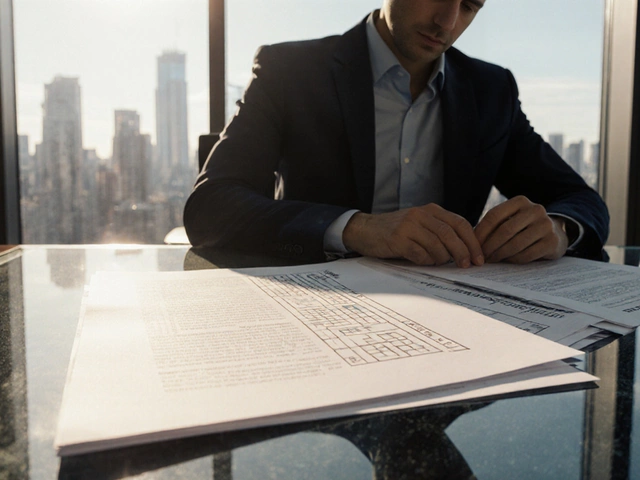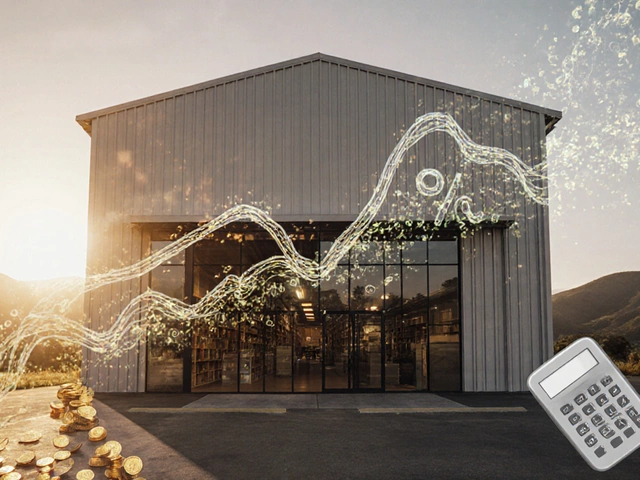Understanding ROI for Commercial Property Investments

If you're diving into the world of commercial property investment, you're probably wondering what a good Return on Investment (ROI) looks like. Here's the deal: ROI isn't just a fancy term thrown around in glossy brochures. It's the backbone of understanding how well your investment is performing.
To put it simply, ROI is a measure of profitability. For commercial properties, a 'good' ROI generally means your investment is yielding higher returns compared to the costs involved in acquiring and maintaining the property. But here's the kicker—what's considered 'good' can vary significantly depending on location, the type of property, and market conditions.
Let's break it down further. Think of ROI as your financial yardstick. It's not just about the numbers ticking up in your bank account; it's about ensuring those numbers are satisfactory enough to outpace other investment avenues like stocks or residential real estate. And in a market that's ever-changing, knowing how to calculate this accurately can give you a significant edge.
- Defining ROI in Commercial Real Estate
- Factors Influencing ROI
- Evaluating Market Trends
- Tips for Maximizing ROI
- Common Pitfalls to Avoid
Defining ROI in Commercial Real Estate
So, you've heard about ROI in the context of commercial real estate and you're probably wondering what it actually means for your investment. Let's break it down into easy terms. ROI, or Return on Investment, is basically a measure of how much cash you're getting back compared to what you put in. It’s a key indicator of your property's financial health.
Calculating ROI isn't as intimidating as it might seem. Here's a simple formula: take the net profit from the property (that's your income after expenses) and divide it by the initial cost of the investment, then multiply by 100 to get a percentage. Commercial property investors usually aim for a higher ROI than they would in residential real estate, partly because commercial real estate often involves more risk and complexity.
Why ROI Matters
But why is ROI so crucial? For starters, it helps you evaluate whether the investment is worth the effort. It acts as a comparative tool to assess performance against other properties or investment opportunities. A good ROI metric can also indicate strong market demand, good property management, and the effectiveness of your investment strategies.
- Net Profit Margin: A healthy ROI usually indicates a good net profit margin, meaning your property is generating income efficiently.
- Asset Value Growth: Over time, a consistent ROI can suggest that your property is appreciating in value.
- Market Competitiveness: A better ROI can make your property attractive to potential buyers or tenants.
It’s also useful to benchmark your ROI against market averages. On average, a good ROI for commercial property sits somewhere between 6% to 12%, but this can skyrocket in prime locations or drop in less desirable areas.
Breaking Down the Costs
When calculating ROI, remember to include all associated costs—not just the purchase price. This includes maintenance, property management fees, improvements, and even taxes. Ignoring these can skew your ROI and give an inaccurate picture of performance.
A detailed approach to understanding ROI helps you fine-tune your investment decisions, leaving you better prepared for both short-term gains and long-term growth. So, whether you're eyeing that office block downtown or a shopping center in the suburbs, getting a handle on ROI is indispensable.
Factors Influencing ROI
When looking at ROI for commercial property, several key factors can make or break your investment. These are the variables that can swing your returns from ordinary to exceptional, and understanding them is crucial.
Location and Market Dynamics
Let's start with the obvious—the location. It's everything in real estate. An office building in a bustling downtown will likely yield a different investment return than one in a sleepy suburb. The demand for space, types of businesses in the area, and economic conditions play a huge role. In markets where rental rates are rising, you might find your ROI soaring too.
Property Management and Operational Costs
Once you've got your property, managing it efficiently is next on the list. Reduced operating expenses can make a significant difference in your bottom line. Things like energy-efficient upgrades might seem costly upfront but can save you loads over time, boosting your investment returns.
Tenant Stability
A stable, long-term tenant can help ensure consistent, predictable income. The fewer vacancies you have, the better your cash flow, and by extension, your ROI.
Market Trends and Economic Conditions
Keeping an eye on broader economic trends is essential. An impending recession might curb businesses from expanding into new spaces, impacting your commercial property's rental rates. Alternatively, in a booming economy, you might find more companies trying to snap up office space, increasing demand and driving up rents.
Renovations and Improvements
Updating your property isn't just about aesthetics. Strategic renovations can increase property value and demand. From modernizing facilities to adding desirable amenities, each improvement can significantly impact your return.
| Factor | Impact on ROI |
|---|---|
| Location | High |
| Market Conditions | Medium to High |
| Property Management | Medium |
| Tenant Stability | High |
| Renovations | Medium to High |
Understanding these factors and how they interact can give you the leverage you need to maximize returns on your commercial property.

Evaluating Market Trends
So, you're curious about how market trends impact your commercial property investment? You're not alone. Keeping an eye on market trends is a smart move for any real estate investor. It’s like having a weather forecast for your investments, offering you key insights on when to buy, hold, or sell.
Understand Market Cycles
Markets usually follow cycles—upward (expansion), downward (contraction), and sideways (stagnation). Right now, many believe we're in an expansion phase for real estate, but staying informed helps you know when we're likely to switch gears. Tracking economic indicators, like employment growth rates and interest rates, can provide clues about where we are in the cycle.
| Indicator | Current Trend |
|---|---|
| Interest Rates | Rising |
| Employment Growth | Steady |
| Commercial Rents | Increasing |
Location Matters
Where your property is located plays a huge role. Is the area experiencing growth or decline? Cities like Austin and Nashville have been hotspots thanks to tech booms and population surges, which can drive up demand and, ultimately, ROI. On the flip side, areas losing jobs might see falling property values.
Technology and Trends
Don’t ignore how technology is changing real estate. Online platforms are making property investment more transparent. Meanwhile, trends like remote work can shake up demand for certain types of commercial properties. For example, flexible office spaces have become more desirable in the past few years.
Stay Informed
Finally, staying informed is critical. Subscribe to real estate journals, listen to market analysts, or even get insights from real estate forums. Many investors also track local regulations, as they can impact property values—zoning changes or new tax laws can either make or break your ROI.
Evaluating market trends might sound overwhelming, but it’s the ticket to understanding the bigger picture and positioning your investment for the best returns.
Tips for Maximizing ROI
Alright, let's get into how to really make the most of your commercial property investment. It's not just about snagging a good deal; it's about keeping your eye on the prize—your ROI.
Choose the Right Location
This might sound like Investing 101, but the property's location can make or break your returns. A property in a growing business district or a region with high foot traffic is likely to attract better tenancy, which means higher rental yields. So, do your research before diving in.
Understand Market Dynamics
The commercial real estate market can be unpredictable. Keep an eye on economic trends, and don't be afraid to adapt your strategy based on what's happening regionally and nationally. For example, if you see a trend in e-commerce, leasing to companies that support this sector might increase your investment returns.
Regular Maintenance and Upgrades
You can't ignore property upkeep. Regular maintenance and strategic upgrades not only keep tenants happy but also justify rental increases. For instance, modern office amenities or eco-friendly upgrades can attract top-tier tenants willing to pay a premium.
Maximize Occupancy Rates
Empty properties don't pay the bills. Ensure your property remains attractive to potential tenants by investing in marketing, hiring a reliable property management firm, and staying competitive with your lease terms. A fully occupied building is a profitable one.
Negotiate Smart Lease Contracts
Crafting a favorable lease agreement can significantly boost your ROI. Consider factors like lease length, rent escalation, and tenant responsibilities for repairs. Aim for tenants who will stay for the long haul, reducing turnover costs.

Common Pitfalls to Avoid
So, you're thinking of investing in commercial property? That's great, but you need to sidestep some pitfalls that could turn your investment sour.
Ignoring Location Dynamics
Location. Location. Location. You've heard it a million times for a reason. Many investors make the mistake of purchasing properties in areas without researching the local market dynamics. Is the area growing or declining? Are businesses moving in or out? Knowing this can save you from a stagnant investment.
Underestimating Operational Costs
Sure, you bought the property at a great price, but have you crunched the numbers on maintenance, property management, and potential renovation costs? These can eat into your ROI faster than you think. Always have a detailed cost analysis ready before you buy.
Vetting Tenants Carefully
Choosing tenants is not just about filling spaces. Bad tenants can lead to lower income and higher management efforts. Make sure to check their background, financial status, and business history to avoid any surprise headaches down the road.
Ignoring Market Trends
Investing without understanding current market trends can be costly. Whether the commercial sector tilts towards retail, office space, or warehouses dramatically affects the value and desirability of your property. Staying updated on trends is vital for a good ROI.
Lack of Diversification
Putting all your eggs in one basket is risky. Relying solely on one property type or location might make you vulnerable. Spread your investments across different property types and locations for a balanced portfolio, which can help enhance your returns over time.
Avoiding these pitfalls can improve not only your profits but also your peace of mind. Armed with this knowledge, you're on a better path to making a smart investment!









Write a comment